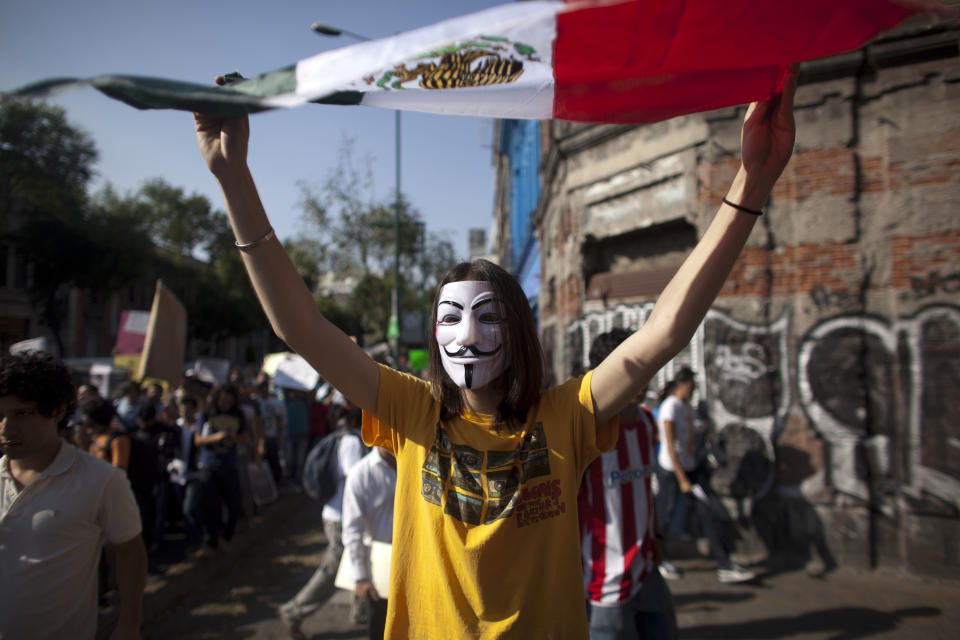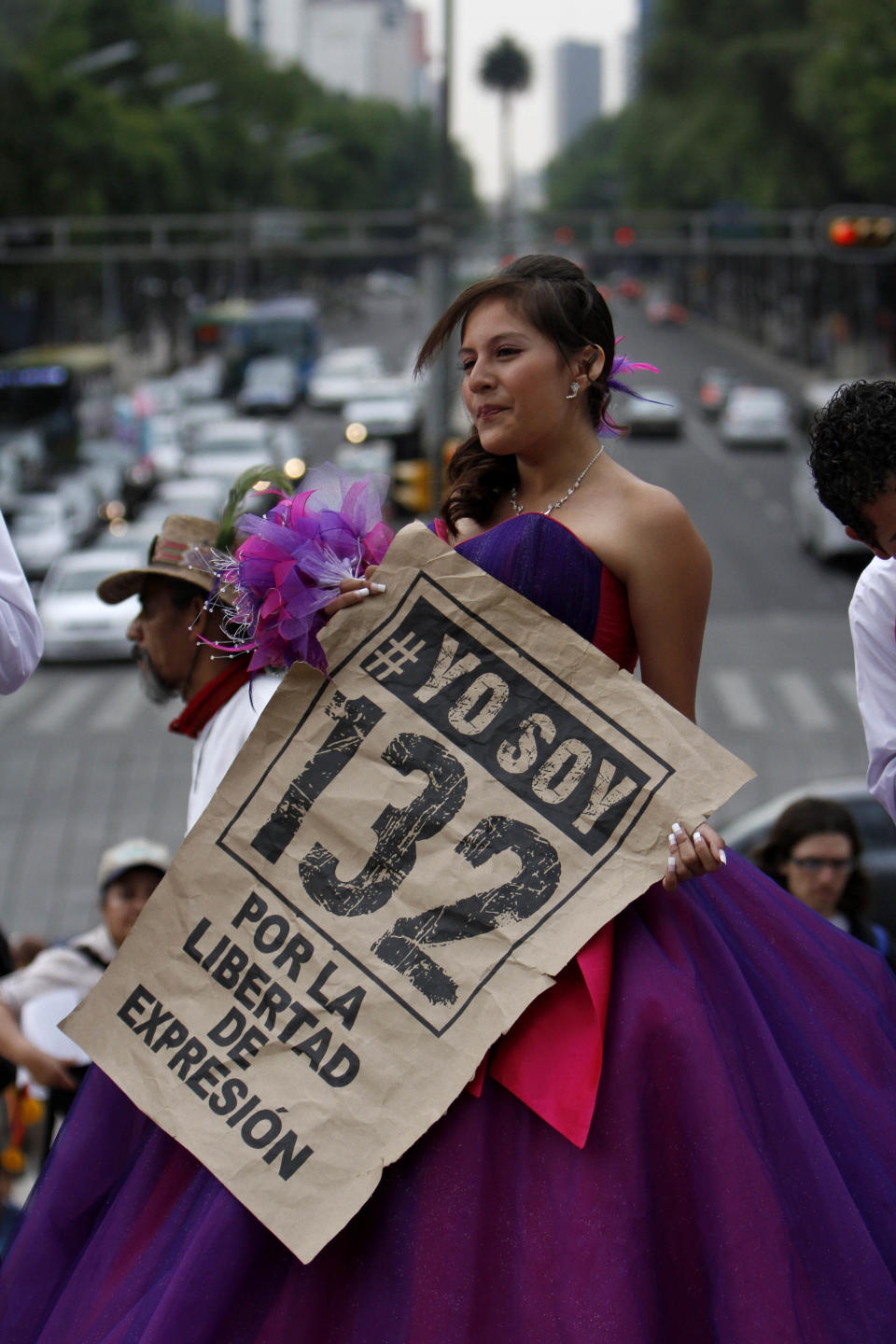Fear of past, ire at present divide young Mexicans
MEXICO CITY (AP) — With signs shouting "No to repression!" and "Down with the PRI!" the angry students who have taken the streets of Mexico with flash protests have become the most visible face of youth in this election.
They have challenged the presidential candidates to debates, urged others their age to pay attention to the campaign, and sought to fight off the return of the Institutional Revolutionary Party, which held power for 71 years until its ouster in 2000.
The college students marching in the protests are among the most privileged of the 24 million young people registered to cast ballots on July 1. At the other end of the spectrum sit the majority of Mexico's young who live in poverty, did not graduate from high school, and earn less than $10 a day.
But unlike the elections of 2000, when a majority of young voters agreed that the PRI had to go, this election season has seen a sharp division among youth along class lines. Educated voters in this demographic are opposed to the return of the PRI, while the rest of the voters aged 18 to 29 prefer the candidacy of Enrique Pena Nieto over his two major rivals.
The widespread student movement narrowed the lead held by the former ruling-party's young and telegenic Pena Nieto, but he's still well ahead just three weeks before the election.
Among young voters, Pena Nieto is still the preferred candidate with 33 percent in favor, 8 points ahead of the leftist candidate Andres Manuel Lopez Obrador and 10 above the ruling party's choice, Josefina Vazquez Mota. The poll was conducted by the firm Mitofsky from June 8-10 with a margin of error of 3.1 percentage points.
Though they lack consensus over who to choose for president, Mexican young people have much at stake. They suffer from the nation's highest rates of poverty and unemployment, and are the main victims of the six-year-long war against drugs that has left some 50,000 people dead.
"I think they have higher expectations that they deserve better than this," said Rodrigo Aguilera, the Mexico analyst for the Economist Intelligence Unit.
The protesters reject Pena Nieto for his party's past. But like young people in general, they are also disillusioned with the ruling National Action Party, or PAN, which launched the drug war that has become frighteningly brutal. Nor have they been swayed by the position of the left, led by Lopez Obrador, the former Mexico City mayor.
"Now you don't even know who to root for," said Mario Luna Perez, a 27-year-old father of two who quit school after sixth grade and lives in an economically depressed town on the outskirts of Mexico City. "It's all the same, no matter who the president is."
Aguilera noted that the student protests have been unusual in that they target what is viewed as unbalanced media coverage, particularly by the nation's most powerful TV broadcaster, Televisa. The news conglomerate, students argue, is manipulating news coverage to favor Pena Nieto.
For 22-year-old Melissa Rolland, a student at a private university who attended a recent protest with a poster that read "apathy is society's worst enemy," the students have to seize upon the opportunity to be heard.
"This is our big moment where we can demand that they really listen to us," Rolland said.
Young Mexicans make up the largest age group of voters, and the largest segment of the unemployed. The country has increased the number of schools and is slowly making it more possible for children to go to high school. But it has failed to offer jobs for the group that will influence the nation in decades to come.
Authorities here repeatedly warn of drug cartels feeding off of an estimated 8.6 million that fall into a category people call "ni-nis," or "neither-nors," young people who neither go to school nor find legitimate jobs.
The educated struggle to find well-paid jobs, and sometimes any job at all.
Jessica Mejia, a 23-year-old from the central city of Tulancingo, said she studied for five years to get her law degree at a local university and has worked at two small firms that paid about $430 a month. Her best job so far was with a government agency that defends women's rights. It paid her about $850 a month, but the contract was only for half a year and she had to travel every day to rural towns in the state of Hidalgo to meet with domestic violence victims, paying for her own gas, food and sometimes lodging. She says she has spent eight months seeking work.
"It's so frustrating. I've run into so many problems: that I'm too young, that I'm a woman," she said. "Companies are afraid to hire young people. They have told me 'I can't offer you this job because it doesn't pay much and as soon as you find something better, you'll leave.'"
A month ago, people thought Pena Nieto's visit to the elite Iberoamerican University in the wealthy Santa Fe district was going to be one more perfectly staged appearance by the candidate who, at the time, held a lead of about 20 points in opinion polls. Instead, chants of "get out" resonated throughout the student plaza.
His party's ham-fisted attempt to dismiss the protest enraged the students. Pena Nieto said the demonstration was not genuine, and PRI president Pedro Joaquin Coldwell suggested the protesters weren't even enrolled in the college. That night, Televisa ran a segment that did not include the students' side of the story. The next morning, a national newspaper and its sister publications ran a front-page story saying Pena Nieto's visit had been a "success" despite a "boycott."
Using Twitter, YouTube and Facebook, students launched a social media campaign demonstrating that they were in fact just students who thought a return of the old party threatened the ideals of a generation raised on the hope of democratic change. Demonstrators uploaded an Internet video showing 131 people holding their school IDs while reading from a statement lambasting the politicians and media coverage that followed.
Soon activists at universities across the country symbolically joined the movement by waving banners proclaiming, "I am 132." Tens of thousands gathered for marches and meetings in the streets of Mexico City, Guadalajara and Monterrey.
On Sunday, the largest march so far was held in Mexico City, where 90,000 people, including some well-known pop artists, protested hours ahead of the last scheduled presidential debate. Next on their agenda is a face-to-face debate with candidates next week — an invitation Pena Nieto has declined.
Outside Mexico City, in the town of Chicoloapan, part of a state where the leading candidate served as governor until last year, a narrow street welcomed motorists with a ceramic statue of Jude the Apostle, the saint of lost causes.
For Alejandro Velazquez Ruiz, 26, the negative publicity surrounding the front-runner hit home. Velazquez is unemployed, lacks a college education and plays soccer to make money.
"They were all leaning toward Pena Nieto, but now we see all the bad things they say about him," said Velazquez, who quit his job in the capital because he had to work seven days a week for $500 a month as a mortgage lender. "We started to have questions. Now I'm voting for Andres Manuel Lopez Obrador."
But in Texcoco, another town outside Mexico City, 19-year-old Gamaliel Pacheco will back the favorite.
After all, Pacheco was only 7 when the PRI lost power, after decades of continuous rule marked by rigged elections, corruption and patronage jobs. He does not remember that.
"I think they were in power so long for a reason," Pacheco said. "The time PAN was in power, there were a lot of deaths. When PRI ruled, we didn't see that."
_________
Follow Adriana Gomez Licon on Twitter at http://twitter.com/agomezlicon



